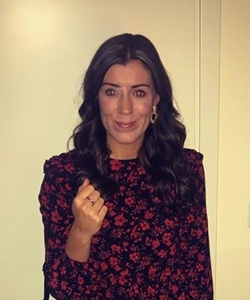 What year did you graduate?
What year did you graduate?
I graduated from Kingston & St George’s University of London in June 2014 and commenced my first role as a band 5 therapy treatment Radiographer at The Royal Preston Hospital in August 2014.
What is your current role?
My current role is a senior (Band 6) proton treatment Radiographer at The Christie NHS Foundation Trust.
How did you get into your current role?
I spent two years in my role as a band 5 Radiographer rotating through treatment and pre-treatment roles, until I gained a band 6 role at The Royal Preston Hospital. My treatment roles involved working with Elekta Linacs and MOSAIQ OMS to deliver a range of radiotherapy techniques, such as IMRT, VMAT, SABR, photon and electron boosts, electrons and superficial treatment. My pre-treatment experience involved utilising Phillips CT scanners to scan patients using 3D /4D techniques, delivering contrast and planning VSIM palliative plans. Although I loved my previous job, I commenced my dream role as a proton Radiographer at The Christie NHS Foundation Trust in April 2019, a role that I had aspired to from being a student. Experience working in pre-treatment and treatment, evidence of service improvement involvement and of further education, such as completion of Masters modules, were desirable factors for the role.
Can you describe a typical day?
A typical day in my treatment role involves treating and managing treatment care for patients having proton beam therapy. This involves daily imaging, whether it be 2DkV or CBCT imaging prior to treatment and I treat patients of a range of ages, under GA and not requiring GA. I prepare documents ready for patients, prior to them commencing treatment (the department is paperless), conduct first day interviews; attend service development sessions and provide care and advice for patients and their carers undergoing proton beam therapy. My role involves training other Radiographers on set during their induction period, which consist of a range of band 5 Radiographers who currently work in the photon department or are in their first band 5 role. I am currently on a six month rotation in proton pre-treatment, which involves 3D/4D scanning, cannulating and giving contrast and working alongside diagnostic Radiographers in proton MR, and scanning patients.
What do you enjoy about your role?
I really enjoy my role as it is varied from day to day. For example, one day may consist of following patients under GA through their pre-treatment pathway (CT followed by MR) and attending MDTs to learn about new patients before they come for their assessment visit, however a different day may consist of scanning a variety of non-GA patients and assisting in pre-treatment play preparation for paediatric patients. I feel like I am always learning in my role, which makes my role more interesting.
What do you find challenging in your current role?
My role is emotionally challenging sometimes, as patients travel from all over the country to stay in Manchester for weeks or months, some patients become upset as they miss home and family. It is really important to empathise with patients. I find that providing information, support, a listening ear and adding a bit of humour to the day helps to uplift spirits.
What advice would you give to a current BMS student at St George’s who is keen to get in to a similar area of work as you?
I would advise gaining as much experience in treatment and pre-treatment rotations, as well as data preparation and planning, if possible, to enable a really good understanding of different aspects of radiotherapy, which can then be applied to proton beam therapy. I would advise doing some research about proton beam therapy, such as upcoming trials, including the TORPEDO head and neck trial.
Which aspects of your degree are relevant for your current role?
All aspects of my degree are relevant to my current role, including inter-professional collaboration, as although therapy Radiographers often work in small teams, my role involves working with an array of healthcare professionals, such as Key Workers, Dieticians, Speech & Language Therapists, Physicists and Clinical Oncologists.
What would you say were the best / most challenging things about your degree?
The best thing about my degree was having a mix of clinical blocks and academic, as this kept the degree interesting and enabled information learnt in academic blocks to be applied clinically. The most challenging thing about the degree was travelling to and from placement as it involved getting a couple of trains and a bus, however, it wasn’t too bad!
If you could go back to your time at St George’s, would you do anything differently?
I would have taken more advantage of the library services and also the learning about anatomy as it is invaluable in clinical practice - for example, in pre-treatment CT and MR or when imaging on set.
Do you have any advice or a message for current students at St George’s?
If you feel like it is getting tough trying to manage University work, assignments and placement, take a deep breath and remember that you can do it! It is definitely worth all of the hard work so keep going!
Do you have any advice or a message for students considering studying at St George’s?
St George’s is a brilliant place to study, as there are lots of opportunities to get involved with different projects and to meet lots of different people with different backgrounds, which is what working in radiotherapy involves! All of the academic tutors are so supportive, friendly and approachable too.